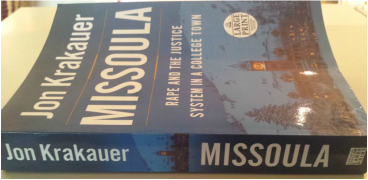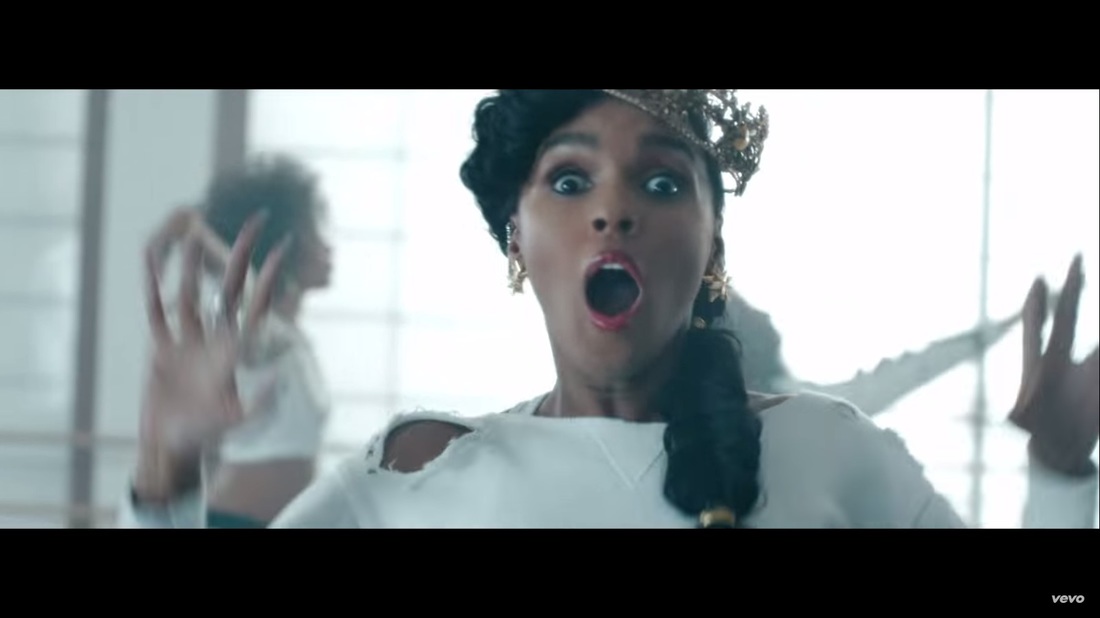- Krakauer provides detailed, comprehensive accounts of a few sexual assault cases. We’re talking everything from victims’ narratives to what rapists said in court to what prosecutors did or didn’t do in each case to what got said behind (and in front of) closed doors. You really get the big picture of how cases can go down, why few rapists get punished (whether through the criminal justice system or campus judicial process), how personal and political connections in a community can mean victims aren’t believed, and the impact of almost everyone at every stage of the process embracing super damaging myths about rape. To be honest, it’s a lot to take in, and this is coming from someone who has been involved in crisis response work full and part-time for almost a decade. It’s super informative and real, but dang, it’s a tough read. If you’re someone who has experienced sexual violence or you’re a crisis worker in major burnout mode, proceed with caution. This brings me to next point:
- Reading this book necessitates accompanying self-care. At least that’s my take. It took me much longer to get through a book this size than I would normally need because I had to take breaks. I came to dread reading it and longed for it to be over, though my determination to finish it helped me plow through. It was drudgery. In its attempt to give an outsider a look into how these things play out, those of us in the know read on with negatively cynical “Yep-seen-this-before-let-me-guess-what’s-next-no-surprise-here-we-go-again-everything-sucks” kind of mentality. I even realized, as I was reading, that I was more short-tempered and angsty then usual, which gave me even more motivation to just keep reading so my time with the book would be finished. So if you are going to read this book, I recommend hot baths, intense cardio, and whatever things you do to keep yourself sane and not intensely angry or sad all of the time. Seriously. Because this book made me want to yell at everyone about how messed up the world is (which I was mostly successful at not doing), and cry at how helpless I feel to change the system this book documents (which I did more than once, followed by unhealthy eating and/or long napping). But, should you get through the book, I’m guessing you might agree that:
- The cases in this book are not unique to Missoula. So the criticism you might have heard Krakauer receiving for his focus on this specific college town in Montana is moot. The thing is—and he makes this clear in the book—Missoula is not unlike most other campuses and communities responding (badly) to criminal and campus judiciary cases involving sexual assault, whether you’re talking statistics or specific details. The stuff he documents happens everywhere, including the crummy ways prosecutors can treat victims and the incapacity of community members to believe that someone they worship (an athlete, for example) could commit sexual violence. It got me thinking a lot about an Illinois county prosecutor—in a county I lived and worked in—who not only refused to charge a woman’s rapist with sexual assault but charged her with felony false reporting instead. Or the high school athletics coach in rural Missouri who was so adored by our community that folks organized rallies and painted their cars in support of him even after six high school girls came forward with allegations of sexual abuse and harassment. I’m sure you’ll make your own connections to the accounts in this book, and that itself is disturbing: far too many of us know the realities involved in sexual assault cases. What is different about this book, at least for me, is that:
- Krakauer offers a compelling parallel between sports and courtroom culture. In addition to its thoroughness, the thing I appreciate most about Missoula is the parallel Krakauer draws between sports culture and what’s happening in courtrooms—and this is that they’re both centered on winning. Just as athletes duke it out on the field with the goal of dominating the other team, prosecutors’ main goal is to win cases, not necessarily to fight for what is “good” or “just,” even when it comes to sexual violence. I’ve seen this play out so many times: police will do a competent investigation and gather solid evidence and testimony only for the prosecutor to refuse charging the accused rapist because they might not win the case. Usually, this is because of rape myths: if the victim was drinking, made decisions to go to a guy’s place, or does not resemble a “credible” (read: believable or likeable) victim (this is where factors of race, social class, population, reputation, etc. get figured in), they know that this will impact the findings of a case. So instead of taking on the responsibility to educate judges, jurors, and the public about these myths (which is indeed a challenging task), they often opt to not take on these cases so that they can have amazing-looking records that show how many cases they have won so they can get re-elected. Not only is this a major issue at community and institutional levels, this is a systemic issue that exposes a majorly messed up criminal justice system ill-equipped to respond to sexual violence in any meaningful way, at least most of the time. This being so, my opinion is that:
- The folks who really need to read this book are ones with power and influence on campuses and in communities. For those of us who work in the movement to end gender violence, this book offers little more than validation of the kinds of things we are witnessing in our own communities across the United States. For folks without the inside knowledge, I could see this book as a productive introduction, and imagine it being read in college-level criminal justice classes. Where I think it holds the most promise, however, is in the hands of people with power and influence to make change on the institutional level—I’m talking prosecutors and judges and university presidents and stakeholders and government officials and legislators and you get the point. The challenge is convincing any of these folks to read a 400-page report about it. Perhaps that it was written by a famous white male mountaineer will help us in this endeavor. I don’t mean this flippantly: as a guy who has climbed Mt. Everest amidst harrowing circumstances and published a ton of award-winning narrative non-fiction, you’d think the fact that he’s writing about sexual assault response would raise some eyebrows. It is, for Krakauer, a new kind of mountain to take on, one that many of us have been climbing for years, and many folks decades before us. And we need all the help we can get.
What to Know About Jon Krakauer’s "Missoula: Rape and the Justice System in a College Town"8/25/2015 This summer I got caught up on some reading. I’d like to say that this involved a sandy beach, tropical drinks, and a stack of smutty novels, but alas, the kind of reading I was intent on catching up on was much less fun. Case in point: John Krakauer’s Missoula. I had been putting off purchasing the book after I first saw it at a feminist bookstore in Madison back in April right after its release because of its almost 400 pages of content. I knew that what I would find in its pages would most likely bear a striking resemblance to my own work with crisis centers, campus officials, and community sexual assault response teams when the systems set up to help victims seek justice and safety utterly fail. And I wasn’t wrong. The book is real, really tough to read, and may send you reeling. So, this post is for folks who are on the fence about reading the book. Or for those of you who know it’s not for you but want to know more about it. Or for anyone processing your own experience reading the book. So, here are my thoughts.
2 Comments
I first witnessed the music video when I was on the treadmill at the gym. I have to admit I was a bit skeptical: I do lots of yoga and for me it’s a physical and spiritual practice that gets my head right and prevents my neck and back from causing me major problems. It’s not something I ever feel sexy doing. I’m way too worried about my spandex inching down my ass and my boobs falling out while I’m in downward dog, not to mention the loud Ujjayi sounds I make with my breath to distract myself from comparing my body to the skinnier and leaner ones next to me adorned in Lululemon. I also fart a lot. See? Not very sexy. But Janelle Monáe reminds me that in addition to all of the things I express through my body, like my awkward attempts at asanas, the occasional yoga breakthrough (like that one time I did full-on wheel pose ALL MY MYSELF in my living room), and my commitment to groundedness, my body is also a sexual body, even while doing yoga. I know, I know, Janelle is singing about getting down at the club, but there’s something about the song that gets me thinking about how yoga has helped me to be more comfortable in my body, especially since experiencing sexual assault. It has helped me to be more confident, healthy, and self-aware, more focused on my body’s (physical, emotional, and sexual) needs, and more flexible (mentally as well as physically). It hasn’t drastically changed my physical appearance, but I have certainly developed more of an existence of being in myself, if that makes any sense. Yep, yoga has been life-changing for me. So, back to the song. If you haven’t heard it, you must. It’s super catchy and fun and sexy and even better because it’s written by a six-time Grammy nominee on her own record label. The video is great because I can dance along to the chorus (seriously—the moves are super follow-able for us the common folk who wish we could dance and actually feel like we can kind of dance with moves like this) and feel all empowered while I do it with lines like: “I ain’t got no worries, I’m my own private dancer” and “Crown on my head but the world on my shoulder / I’m too much a rebel, never do what I’m supposed ta.” Not to mention that I love how Janelle takes yoga out of the context of studios filled with upper white class women and owns it by her own terms. And then there’s the last part of the second verse: “You cannot police me so get off my areola, get off my areola.” So this is the point as you’re reading this that if you haven’t seen the video, I recommend you watch it now. I’m serious. You have to watch Janelle’s face when she sings, “areola.” It’s this amazingly awesome moment in which she achieves a balance of resistance, boldness, self-awareness, and humor. Whether she is speaking to the truths of black women or all women, she’s saying something about the policing of bodies and sexuality and sexual expression and self-expression. And the way she does it is brilliant, because it is inviting rather than alienating. Some folks have suggested that she’s making a nod to #freethenipple, and that may be true, but I think the line is about so much more than that.
It’s a reminder about how women’s bodies are still objectified, commodified, trivialized, and controlled. It makes it seem ironic, then, that “areola” was censor-worthy when Janelle performed “Yoga” on The Tonight Show back in May. If you listen closely, she actually sings something that sounds like “little ola.” The performance is still great, but come on. I didn’t even know “areola” was considered profane, let alone not suitable for late-night programming. Still, Janelle reminds us that “Sometimes I’m peachy, and sometimes I’m vulgar / Even when I’m sleeping I got one eye open.” She may have self-censored, but she’s aware of it and she will find other ways to express resistance. At least this is what I like to think about her performance. At any rate, I’m still in love with the song and the way Janelle creates space for bodily agency and empowerment. Though some arguments can be made for “Yoga” catering somewhat to a hetero male audience—and such points made stronger by some of Jidenna’s lyrics—Janelle has made it clear in the past that she’s a feminist and that she is “not for male consumption.” In a culture in which we are still struggling against slut-shaming, abstinence-only education, rampant sexual violence, and victim-blaming, “Yoga” offers an affirming path for self-loving sexuality. I think the key, as Janelle models, is to not take ourselves too seriously. Some of my favorite yoga instructors offer the same mantra: work hard, but do it with a sense of humor. This kind of feminist resistance is fierce and focused, but invitational. Feminism, like yoga, should be flexible and self-aware and strong, but it can also be fun, sexy, humble, and willing to laugh at itself. And if this is the kind of feminism we engage in, maybe more folks will join us. After all, no one wants to join a yoga class full of uppity snobs only concerned with appearances and showing off. Let’s flex our humor-filled feminist muscles with Janelle. We might even achieve a kind of feminist nirvana. |
Author
Jenn Freitag, Ph.D. is an educator, activist, scholar, and performance artist committed to ending gender violence. Archives
January 2017
Categories
All
|



 RSS Feed
RSS Feed